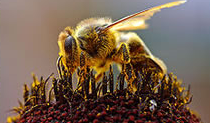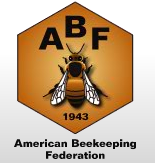 I foster a years-long ritual at the Minnesota State Fair. No, it doesn’t have anything to do with anything that's deep fried, on-a-stick, or makes you throw up the more you ride it – which is not to say I don't also go for such dalliances. But I’ve grown into a few adult-onset educational adventures as well. I’ve found myself checking out the animal barns (although the lamb wearing the “which cut is this” t-shirt last year firmly reinforced my inability to eat that particular animal … baaaa), visiting the Fine Arts building, and buying beautiful locally produced wools for my 2-year old knitting obsession. And each year, I simply must buy honey at the state fair. I adore honey in all its different flavors and colors. I love eating it, stirring it into hot tea, and cooking with it. And I love the idea that it comes from the local producers here in Minnesota and not some mass producer that homogenizes and flattens out the flavor. This year, I decided to dig a little deeper to learn more about the bee keeping and honey making process.
I foster a years-long ritual at the Minnesota State Fair. No, it doesn’t have anything to do with anything that's deep fried, on-a-stick, or makes you throw up the more you ride it – which is not to say I don't also go for such dalliances. But I’ve grown into a few adult-onset educational adventures as well. I’ve found myself checking out the animal barns (although the lamb wearing the “which cut is this” t-shirt last year firmly reinforced my inability to eat that particular animal … baaaa), visiting the Fine Arts building, and buying beautiful locally produced wools for my 2-year old knitting obsession. And each year, I simply must buy honey at the state fair. I adore honey in all its different flavors and colors. I love eating it, stirring it into hot tea, and cooking with it. And I love the idea that it comes from the local producers here in Minnesota and not some mass producer that homogenizes and flattens out the flavor. This year, I decided to dig a little deeper to learn more about the bee keeping and honey making process.
Lots of us know that we have many beekeepers and honey producers in the state of Minnesota, but did you know that Minnesota is one of the top 6 honey producing states in America? Our bees crank out more than 13 million pounds of honey annually! I had no idea. During my first visit to the fair this year, I attended a couple of bee/honey-related seminars, along with a couple of cooking demos, and I capped off my visit with my annual taste testing and selection of honey to bring home. The most interesting presentation, in my opinion, was that of Gary S. Reuter, a scientist from the University of Minnesota – catch him at the ECO Experience building if you can. The end result of this whole endeavor was that I found myself completely fascinated by bees. My knowledge was considerably more basic than I thought, but our fair makes the whole vague matter that much more accessible. But bee warned (sorry); once you hear all of the intriguing facts and figures around bee keeping and honey production, you too may find yourself with a new obsession - and a delicious one at that.
 Because of my developing interest in our local food systems, I was astounded to learn that more than 1/3 of our American food supply depends on the efforts of pollinating insects, the largest portion of which is honey bees. Think about it: all that pollination happens on the backs of honey bees going about their nectar collecting business. And not just the more obvious fruits and veggies, but coffee, chocolate, nuts, and crops such as the clover, alfalfa, and hay produced to feed grazing animals. In fact, the state of California needs more than a million colonies just to pollinate almond trees; due to many factors – including the recent-onset of Colony Collapse Disorder (CCD) – they only have about half of that, so the remainder are trucked in to do their duty and move on. This was another interesting tidbit: something like two-thirds of the nation’s bee colonies go mobile in order to help facilitate the pollination process. The bees start in Florida to get the citrus crops going and then truck up the eastern seaboard – stopping to pollinate particular crops along the way – to Maine where they work on blueberries. The scope of their work is amazing.
Because of my developing interest in our local food systems, I was astounded to learn that more than 1/3 of our American food supply depends on the efforts of pollinating insects, the largest portion of which is honey bees. Think about it: all that pollination happens on the backs of honey bees going about their nectar collecting business. And not just the more obvious fruits and veggies, but coffee, chocolate, nuts, and crops such as the clover, alfalfa, and hay produced to feed grazing animals. In fact, the state of California needs more than a million colonies just to pollinate almond trees; due to many factors – including the recent-onset of Colony Collapse Disorder (CCD) – they only have about half of that, so the remainder are trucked in to do their duty and move on. This was another interesting tidbit: something like two-thirds of the nation’s bee colonies go mobile in order to help facilitate the pollination process. The bees start in Florida to get the citrus crops going and then truck up the eastern seaboard – stopping to pollinate particular crops along the way – to Maine where they work on blueberries. The scope of their work is amazing.
Like many other issues that affect our agriculture system, the health and well being of bee colonies has become a hot button topic, and for good reason. The combined effects of pesticides, disease and the somewhat inexplicable CCD have put a strain on the bee population. A mono-cropped agricultural system doesn’t help. So, if you care about locally available produce and other products, do what you can to support the bee keeping industry. Become a bee keeper! Buy honey! Or try one of these ideas:
- Plant a garden (here’s a great article about preserving pollinators for gardeners)
- Let wildflowers and other weeds grow in greenspaces
- Limit the use of pesticides
- Support bee research
- Buy more honey! (Did I mention that already? I really, really like the stuff.)
While I'm back on the subject of honey, I also want to mention some of its health benefits, including treatments for allergies, burns, and wound and throat care.
 After my state fair education - sampling several different kinds of honey and picking up a new version to try (dark wildflower honey from Ellingson’s in Odessa MN for $5.75) - I was ready to get down to the business of food. In addition to recipes provided by the fair’s presenters, I found a few others that got me going. Try them out and let us know what you think!
After my state fair education - sampling several different kinds of honey and picking up a new version to try (dark wildflower honey from Ellingson’s in Odessa MN for $5.75) - I was ready to get down to the business of food. In addition to recipes provided by the fair’s presenters, I found a few others that got me going. Try them out and let us know what you think!
- Honey Cole Slaw (and other recipes from ABF)
- Fresh Figs with Goat Cheese and Peppered Honey
- Polenta Cake with Orange Blossom Yogurt, Berries and Pistachios
- Smitten Pears Martini (other honey cocktail recipes here)
- Or my simple favorite, take a graham cracker or Wasa wafer, spread with natural peanut butter, top with sliced apples or a Wasa wafer and drizzle with honey ... perhaps the perfect breakfast!
I owe the details here to: Bee Lines newsletter available at the Ag/Hort building; the presentation by Gary S. Reuter from the U of M’s Bee Lab; the American Beekeeping Federation; and wikipedia.com.
Tracy Morgan is a Twin Cities foodie and the owner of Segnavia Creative, a marketing services consulting company located in St. Paul, MN. She is a regular contributor to Simple, Good, and Tasty.
This post was proudly submitted to Food Renegade's Fight Back Friday.



